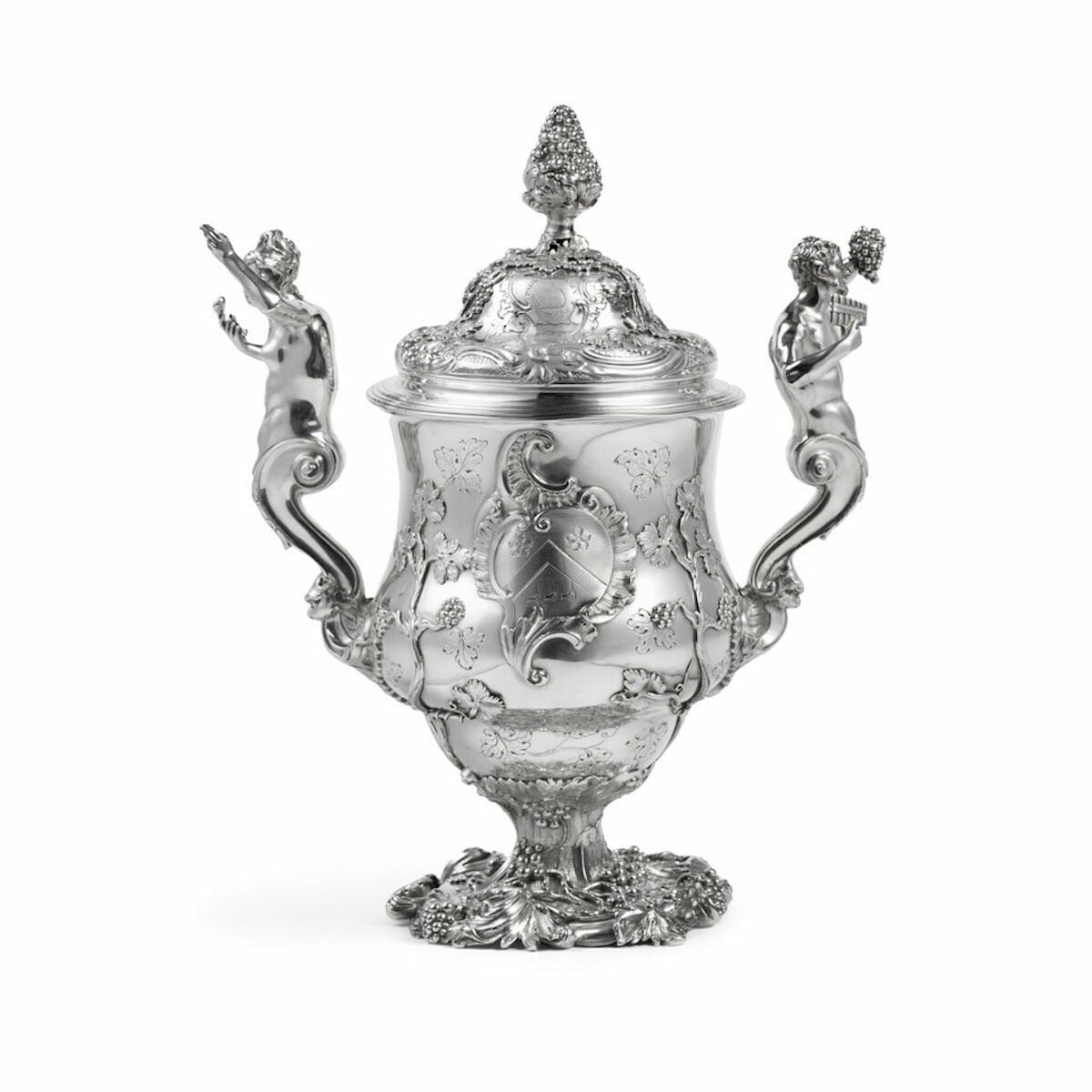HBF buys one-of-a-kind artifact commissioned by ‘Gentlemen of Port Royal’
By Mike McCombs
The Island News
It’s not the holy grail. But relative to the history of Beaufort, it’s not far off.
On January 23, the Historic Beaufort Foundation (HBF) successfully bid on an historic silver cup and cap commissioned in 1748 and presented by “the Gentlemen of Port Royal” to British Capt. Joseph Hamar, commander of His Majesty’s ship Adventure, for protective services around Beaufort and Port Royal.
It is a one-of-a-kind artifact distinctly tied to Beaufort’s history that, despite its importance, almost nobody even knew it existed.
“None of the historians knew about the cup,” HBF Executive Director Cynthia Jenkins said. “They knew about Hamar and the Adventure … but it’s been in private hands all these years.”
Hamar’s Cup was given to Sotheby’s to auction by a family on New York City’s upper east side, according to Jenkins, and someone tipped her off about its existence.
Jenkins said HBF bid on the silver cup and cap in partnership with a number of donors who contributed to a special fund for the purchase. She declined to share the purchase price with The Island News.
The cup was item No. 828 at the Jan. 23 auction – “George II Silver Presentation Cup and Cover of South Carolina Interest. Thomas Heming, London, dated 1748.” Its estimated sale price, according to Sotheby’s, was $15,000 to $25,000.
Turns out that estimate was a bit low. The cup and cap sold for $56,700.
Wayne Vance, chair of the Historic Beaufort Foundation Board of Trustees, applauded the purchase. “This is an exceptional accomplishment, to bring home to Port Royal Island the original silver cup from 1748 that meant so much to our young town 274 years ago,” Vance said in HBF’s news release. “To secure the actual antique cup, not a reproduction, and to eventually make it accessible to the public, is remarkable. We want to thank everyone who contributed to make this possible.”
“It’s so rare to have anything from Beaufort that early that’s this quality,” Jenkins said. “Our board was determined that it should become to Beaufort.”
About the cup and cap
According to Sotheby’s, there are few comparable items to this 13.5-inch silver cup and cap crafted by Thomas Heming of London. The auction house’s experts said the Heming cup and cover “is among the earliest and most sophisticated examples of rococo silver which can be linked to the American Colonies.”
Heming began his apprenticeship in London in 1738. The South Carolina cup represents his very early work. It was crafted well before he would go on to be named Principal Goldsmith to King George III in 1760, according to Sotheby’s.
The item was listed by Sotheby’s as a “George II Silver Presentation Cup and Cover of South Carolina Interest, Thomas Heming, London, dated 1748 … of double-bellied rococo form, the scroll-edged foot case with trailing grapevine, continuing up the body and extended by engraved representations, flanking two rococo cartouches engraved with contemporary arms and presentation inscription, matching cover with crest and motto below grape cluster finial, scroll handles topped by caryatids of a bacchante and a satyr with grape cluster and pan pipes, marked under foot with lion passant, leopard’s head crowned, and maker’s mark twice, one obscuring another mark.”
Colonists from South Carolina commissioned the silver cup less than 40 years before the American Revolution and less than 40 years after Beaufort was founded in 1711.
“It’s in extremely good shape, with beautiful markings and no scratches,” Jenkins said. “An extremely beautiful piece.”
The inscription on the cup reads:
The Gentlemen of Port Royal
So: Carolina
Present this Plate to Captn: Hamar
Comdr: of his Majts Ship Adventure. in
Gratefull Acknowledgment of his Services
Done to this Port in ye Year 1748
Why Hamar’s cup was important
Prominent Beaufort historian Larry Rowland, Ph.D., didn’t have any knowledge of this cup until recently.
“No, I had no idea,” he said. “I doubt if anybody in Beaufort had any idea.”
And then he read what was inscribed on the cup.
“As soon as I read the inscription on it, I knew what it was about,” he said. “(HBF) just needed to decide what to bid on it.”
In the years before the cup and cap were made, Beaufort and Port Royal, as well as Charleston, were struggling to develop in terms of commerce and shipping thanks to almost constant naval warfare between British Charleston, and Spanish and French privateers.
During King George’s War (the War of Jenkins’ Ear), the British were fighting Spanish Florida, and possession of Georgia was in the balance. It was a principal event in Beaufort and Port Royal.
In 1740, S.C./Georgia forces under General James Oglethorpe laid siege to St, Petersburg. Oglethorpe eventually failed, and the naval war that followed was costly to Charleston commerce.
The Spanish were clearly winning the naval war in the 1740s.
The colonists lobbied the Royal Navy to base ships at Port Royal. The British chose Port Royal over Charleston because the harbor was deeper and there was a natural formation of the riverbank, where Ribaut Road exists now, that allowed them to lift ships in the water and work on them at low tide.
“It was really the first Royal Naval establishment in Carolina,” Rowland said.
Capt. Hamar, the first commander of the Royal Naval Station in Port Royal, and his ship, the HMS Adventure, helped turn the tide and successfully defended Beaufort and Port Royal from the Spanish.
“It’s easy for us to forget today how important the maritime location of Beaufort was,” Jenkins said. “And it’s what makes it special today.”
According to Rowland, the treaty of Aix-la-Chapelle in October 1748 ended King George’s War and the Anglo-Spanish dispute over Georgia.
Stability and economic benefits brought by the presence of the Royal Navy ships helped establish Beaufort and Port Royal as centers for commercial shipping.
This is where the “Gentlemen of Port Royal” came into play.
Obviously a group of prominent citizens, the “Gentlemen” commissioned the cup and cap as a gift to Hamar for his defense of Beaufort and Port Royal.
But who were the “Gentlemen of Port Royal?”
Rowland didn’t hesitate to give “his best guess,” saying he had little doubt who two of the “Gentelmen” were.
“One was Lt. Gov. William Bull of Sheldon,” Rowland said. “(This victory) would have been very important to him personally and politically. And he was one of richest people in America at the time.”
The other?
“Col. Nathaniel Barnwell,” Rowland said. “The eldest son of Tuscarora Jack (John Barnwell), Oglthorpe’s aide de camp. He would have been most interested and he could afford it.”
Rowland said, “Those two I’m sure are two of the ‘Gentlemen of Port Royal.’ … I’d be really guessing at any more.”
Rowland said, more than just a rare piece for its artistic value, it was rare as a reward for service.
There were often cash prizes, sometimes even land given for services provided, but “this is a little different,” said Rowland.
Coming home
According to Jenkins, Beaufort expanded its boundaries in honor of Capt. Hamar.
“… the city was expanded,” Jenkins said. “(Beaufort) added two new streets. It had stopped at Bladen Street according to the early maps.”
Two new streets, now within Beaufort’s National Historic Landmark district, Hamar and Adventure, were named in honor of the 1748 heroics, and Capt. Hamar was gifted two lots on the street bearing his name.
Capt. Hamar didn’t stay in Beaufort long, though. He left the Adventure in 1749.
As of now, no one knows if Hamar was given the cup in Beaufort, or if the cup ever actually made it to Beaufort at all. Jenkins and Rowland both say they’re doing their homework, trying to find out.
It could be just as likely he received the cup in London.
Hamar retired from British service in 1758 and died in 1773, just before the American Revolution.
He willed the Cup and Cap from the Merchants Of Carolina to his daughter Mary Elizabeth Hamar Arden. From her, it eventually made its way to Sotheby’s.
“It’s a big story as a historian,” Rowland said. “It’s a sort of keystone of our colonial history with the Spanish in Florida. A big piece of history.”
“To see this item come up for auction, with its direct and historic ties to Beaufort and Port Royal, really was a once in a lifetime opportunity,” Vance said.
It will likely be a couple more weeks before it makes its way to Beaufort, maybe for the first time.
Now that the HBF has the Cup and Cap, Jenkins’ isn’t certain what comes next. They want to display the piece for the public to appreciate, but they honestly don’t know exactly how they’ll do that.
“The attitude was, ‘we need to see if we can get it to Beaufort, and then we’ll figure all that out,’” Jenkins said.
Jenkins does know one thing for sure though.
“I know that we won’t be drinking out of it,” she laughed. “They did. That’s what they did, that’s what it was used for. But I think if we do anything, we’d be handling it with white gloves.”
Mike McCombs is the Editor of The Island News and can be reached at TheIslandNews@gmail.com.








